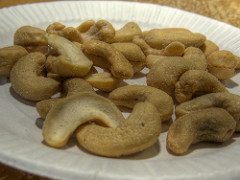If you’ve suffered from food poisoning, chances are the misery is cemented in your brain. You may recall stomach cramps, vomiting, diarrhea, and other unpleasant symptoms. Food poisoning can, however, be even more serious. Food poisoning can put people in the hospital, cause long-term damage, and even lead to death, especially in vulnerable populations. This is why we practice food safety law and why our food safety law firm in San Francisco, Santa Rosa, and Oakland talks about food poisoning prevention and, when needed, food poisoning lawsuits. As we hear about one of the first large recalls of 2016, we take this opportunity to provide the following Food Poisoning FAQ and safety tips.
Trader Joes Recalls Cashews
As the San Francisco Chronicle reports, the popular grocery chain Trader Joe’s is warning the public that certain  bags of “Raw Cashew Pieces” (barcode 00505154) may be contaminated with salmonella. Specifically, the store’s supplier alerted them to potential contamination in bags labeled “BEST BEFORE 07.17.2016TF4.” Although the initial alert suggests the bags were not sold in California, they were sold in neighboring states and it is still wise to check the packaging. Thus far, no illnesses have been linked to the nuts, but a press release from Trader Joe’s says the nuts have been removed from shelves and asks anyone who has bags from that specific lot to either throw them out or return them to the store for a full refund.
bags of “Raw Cashew Pieces” (barcode 00505154) may be contaminated with salmonella. Specifically, the store’s supplier alerted them to potential contamination in bags labeled “BEST BEFORE 07.17.2016TF4.” Although the initial alert suggests the bags were not sold in California, they were sold in neighboring states and it is still wise to check the packaging. Thus far, no illnesses have been linked to the nuts, but a press release from Trader Joe’s says the nuts have been removed from shelves and asks anyone who has bags from that specific lot to either throw them out or return them to the store for a full refund.
Food Poisoning FAQs
We hear a lot about food poisoning (aka “foodborne illness” and similar terms), but many people don’t know too much about it. Here are some quick facts, based on information found on Food Safety section of the Centers for Disease Control’s Food Safety website:
- What is foodborne illness? Foodborne illness is a broad term used to identify illnesses caused by many different pathogens including bacteria, viruses, and parasites. Beverages may be contaminated too. There are more than 250 different forms of foodborne illness recorded. The term also includes poisonings by toxins such as in poisonous mushrooms. Per a 2011 study, the most common causes of foodborne illness are the norovirus and the bacteria Salmonella, Clostridium perfringens, and Campylobacter.
- How many people get sick from foodborne illness each year? Every year, 1 in 6 Americans (approximately 48 million people) gets some type of foodborne illness. While most people recover independently, 128,000 people are hospitalized and 3,000 die each year in the U.S. due to foodborne illness.
- How does food become contaminated? Contamination can occur at many different points in the production and preparation chain. Examples in the production process include being exposed to infected animal materials and fruits/vegetables being washed/irrigated with water contaminated with manure or sewage. In the preparation process, examples include infection via contact with unwashed hands that are carrying bacteria or contaminated surfaces (e.g. cutting boards, utensils). Importantly, cooked foods can be re-contaminated via contact with raw foods or infected handlers. Certain foods like eggs and oysters are especially prone to carrying pathogens that can make people sick.
- What are the symptoms? Although there isn’t just one picture of foodborne illness, typically symptoms start in the gastrointestinal tract and may include abdominal cramps, nausea/vomiting, and diarrhea. Symptoms can range from mild to severe depending on your health status and the type of bacteria involved. People who believe they may have a foodborne illness should seek help if symptoms become severe (e.g. high fever, bloody stool, dehydration) or last beyond three days. Food poisoning can cause long-term damage or even death.
- How can I prevent food poisoning? The CDC recommends this four-part approach:
- Cook – Only a food thermometer can truly tell you whether a food is safe (see the CDC’s site for details on temperatures needed to kill contaminants);
- Clean — Wash hands, surfaces, and anything used in food preparation. Also wash all fruits and vegetables before eating);
- Separate – keep raw foods separate from ready-to-eat items;
- Chill – Refrigerators should be kept below 40 degrees. Germs may grow in unrefrigerated foods within 2 hours (1 hour in the summer heat).
A Food Poisoning Lawyer in Northern California
Not every case of food poisoning should lead to a lawsuit. However, if a person or company’s negligence causes a severe case (or multiple cases) of food poisoning resulting in serious illness or death, the responsible party should be held accountable and financially liable. Our San Francisco food poisoning lawyer can help. Remember: The sooner you call, the better.
See Related Blog Posts:
Foodborne Illness Litigation: Examining the Law and Looking at a Shigella Outbreak in San Jose
Food Allergy Litigation in California
Contaminated Water and the Threat of Waterborne Illness
(Image by Razor512)
 San Francisco Injury Lawyer Blog
San Francisco Injury Lawyer Blog

